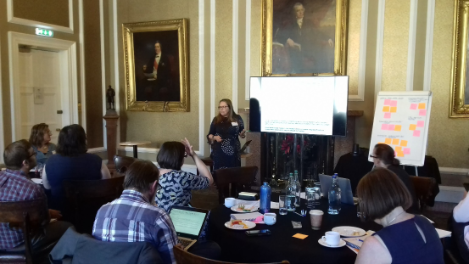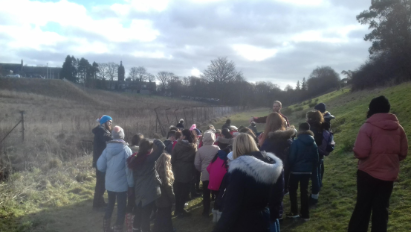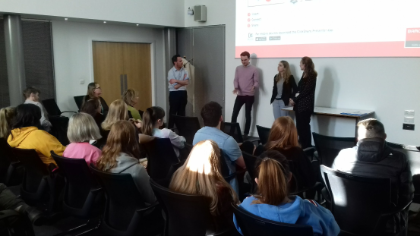Why does resilience matter, and how can we get there?
Published: 27 October 2020
In this blog, Dr Leslie Mabon, an environmental scientist, explores the tensions that run through his research into resilience.
Dr Leslie Mabon, Senior Lecturer in Social Science
Scottish Association for Marine Science
You can read more about Leslie's research on his blog energyvalues.wordpress.com, or on Twitter @ljmabon.
In this post, I’d like to talk about the tension that runs through my research into resilience, and offer some thoughts on how this tension might be reconciled or at least acknowledged.
On one hand, I’m an environmental social scientist, strongly interested in social justice and in how our policy-makers and practitioners weigh up different ways of understanding how the world works. I therefore spend a lot of time – sometimes to the annoyance of my collaborators – expressing a deep scepticism towards shiny high-level initiatives aimed at resilience. I see it as my job to pick holes, challenge assumptions, be the person that always asks ‘really?’ Thinking in this way, I worry that putting our response to climate change in terms of building ‘resilience’ puts the burden for taking action onto the individual or community, deflecting away from social and political factors that make some people more vulnerable than others.
But at the same time, I am also a pragmatist. I try to keep in mind that climate change is very real, that it has the potential to cause serious harm to people, and that there are physical and practical actions we can take to reduce that risk of harm. When I think in this way, and put resilience in a more technical sense of being able to understand complex systems and act before failures and harm occur, then I realise that perhaps a resilient society isn’t such a bad thing to aim for if it reduces the risk of harm.
How best, then, to reconcile these competing forces? How to get things done in the face of pressing resilience challenges, without inadvertently reproducing or reinforcing existing inequalities?

Climate justice, marginalised communities and evidence-driven debate workshop, Royal Society of Edinburgh, June 2019
A good place to start is in thinking how resilience experts communicate who and where is vulnerable to climate risks. In recent years, we have seen more and more efforts to include demographic and socio-economic factors in climate risk maps. The idea behind these kinds of maps is to help people such as planners, emergency services and environmental protection officers to prioritise ‘high risk’ areas for intervention, by identifying locations where physical exposure to flooding, excess heat and other hazards is high and where people’s capacity to adapt may be limited by factors such as income, education levels or age. If these indices are developed sensitively – like the Scottish Government’s Flood Disadvantage work[i] - they can be a powerful tool in bringing resilience-building measures to those who need them the most. But if we are not judicious in how we interpret and act on the information in these indices, we run the risk of stigmatising those living in high-risk areas or – as a friend and former colleague of mine puts it – ‘blaming people for being poor.’ After all, nobody wants to be told they are ‘vulnerable’, or have experts coming in from outside telling them how they can become more ‘resilient’ through patronising or unwanted interventions[ii].
Fortunately, in Scotland we seem to be quite good at doing this kind of climate justice work sensitively. As well as the Flood Disadvantage work highlighted above, another excellent example of how to develop and interpret these tools is a study just published into the spatial distribution of ecosystem services from green infrastructure in Glasgow[iii]. What is significant about this work is that the writing team included an expert in climate justice – Prof Tahseen Jafry - from Glasgow Caledonian University’s Centre for Climate Justice. This meant that the project outcomes were very closely tied to bigger ideas about policy to ensure climate justice.
A second big challenge I see in my own work is linking numerical and spatial interpretations of resilience, with the rich stories people might have about the lived experience of vulnerability to climate change. There is a real danger that as soon as we see neighbourhoods ranked on a list or highlighted in differing shades of orange and red on a map, we fixate on the numbers and the story stops there. But these metrics alone often don’t tell the whole story behind what it’s like to live through or recover from a disaster. In our NCR-supported project into flood risk in Ballater, Aberdeenshire, for example, we heard powerful accounts of how local faith leaders took on the role of leaders in the immediate aftermath of the flood, making decisions about how to ensure access to food and medication in the time when the village was cut off from the outside world and hence from emergency services. We also heard about the good knowledge there was within the village of where the most at-risk members of the community were located, and how this was mobilised to move these people out of harm’s way. Stories like these can give resilience researchers an in-depth understanding of how and why a community might be able to react to external shocks and stresses and ‘bounce forwards’ after the event, but can be hard to represent through an index or set of statistics.
What we did to get round this challenge in our NCR project was make sure that our colleagues in computer science – who were responsible for modelling flood flows and visualising the movement of water through Ballater to develop a planning tool for evacuation from future floods – got to hear these stories too, by coming out to meet the community and getting to read our social science findings. This meant that they had an understanding of aspects the socio-economic data can’t always tell us, things like who the people are in the community that are trusted, and hence who might need to know about the flood models; what information and data people want and need; and even what some of the barriers to technology being useful might be (anecdotal knowledge told us phone and data signals were knocked out by Storm Frank, meaning anything needing an internet connection for real-time data might be useless). In my work from now on, I’d like to find ways to get these stories and narratives up in front of policy- and decision-makers alongside quantitative and spatial data.
Resilience is a useful and important organising concept as we respond to climate change and other – perhaps yet unknown – shocks and stresses that might lie along the way. What I want to do through my work is ensure that this resilience is equitable, and doesn’t place an unfair burden for taking action on those who are least empowered or have least capacity to act. In this post, I’ve hopefully highlighted a couple of areas of practice where we can strengthen the pragmatic benefits of resilience with more critical perspectives.

SEPA-Creative Carbon Scotland Den Burn flood preparation engagement activity, Aberdeen, spring 2019

Robert Gordon University students attending climate change adaptation planning workshop at Aberdeen City Council, spring 2018.
[i] https://www.gov.scot/publications/mapping-flood-disadvantage-scotland-2015-main-report/
[ii] https://doi.org/10.1080/14702541.2020.1834335
[iii] https://www.sciencedirect.com/science/article/abs/pii/S1618866719306545
First published: 27 October 2020
<< Blog

